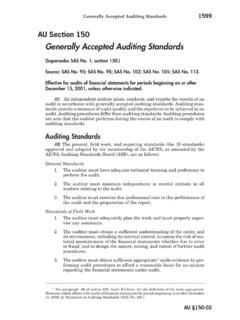

When Section 701 is applied in an audit report, the EOMs paragraph does not substitute for a description of individual KAMs in the “Key Audit Matters” section of the auditor’s report.

Section 706, Emphasis-of-Matter Paragraphs and Other-Matter Paragraphs in the Independent Auditor’s Report (Section 706), was changed to clarify the relationship between Emphasis of Matters (EOMs) and KAMs within the auditor’s report. Those who choose not to include KAMs in the auditor’s report will continue to receive written and oral communications from their auditor separate from the auditor’s report. If the audit does not identify any KAMs, then the audit report will state that within the conclusion. The communication of KAMs in the auditor’s report may also provide intended users of the financial statements with a basis to further engage with management and those charged with governance about certain matters relating to the entity, the audited financial statements, or the performed audit. The communication of KAMs does not alter the opinion on the financial statements taken as a whole. Refer to the financial statement accounts or disclosures related to the KAM.How the KAM was addressed in the audit, and.Primary reason for designation as a KAM,.If engaged in reporting on KAMs, the auditor’s report will describe the following for each KAM item:

#Generally accepted auditing standards and procedures professional
KAMs are communicated with those charged with governance that, in the auditor’s professional judgment, were of most significance in the audit.

Those charged with governance decide for their organization whether or not the auditor reports on KAMs in the auditor’s report. The new standard does not require the communication of KAMs in the auditor’s report. The new standard addresses both the auditor’s judgment about what to communicate as well as the form and content of such communication. The purpose of communicating KAMs is to provide greater transparency about the audit to the financial statement’s external users. Section 701 addresses the auditor’s responsibility to communicate key audit matters (KAMs) in the auditor’s report if and when the auditor is engaged. It establishes a new auditing standard, AU-C Section 701, Communicating Key Audit Matters in the Independent Auditor’s Report (Section 701). The changes are intended to enhance the communicative value and relevance of the auditor’s report. 134 changes the form and content for all auditor’s reports under Generally Accepted Auditing Standards (GAAS). The following is a quick summary of what you need to know about these new SASs: Below is a table that includes a summary of the new SASs, topic, AU-C section affected, and issuance date: SAS NO.Īmendments to the Description of the Concept of MaterialityĪmendments to Incorporate Changes from SAS 134Īmendments to Incorporate Changes from SAS 134 and 137 However, in this case, these new SASs require broader understanding because there are vital decisions for business leaders who issue financial statements that result from these SASs. Traditionally, new SASs aren’t something the general public needs to understand. The AICPA’s Auditing Standards Board has published new Statements on Auditing Standards (SASs): No.


 0 kommentar(er)
0 kommentar(er)
